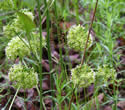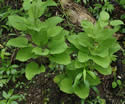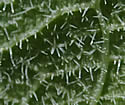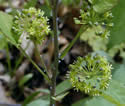Smilax illinoensis (Illinois Carrion Flower)
| Also known as: | Illinois Greenbrier |
|---|---|
| Genus: | Smilax |
| Family: | Smilacaceae (Catbrier) |
| Life cycle: | perennial |
| Origin: | native |
| Habitat: | part shade, shade; average to moist soil; deciduous woods, thickets, floodplains, wooded slopes, bluffs, stream and river banks |
| Bloom season: | May - June |
| Plant height: | 20 to 40 inches |
| Wetland Indicator Status: | none |
| MN county distribution (click map to enlarge): |  |
| National distribution (click map to enlarge): |  |
Pick an image for a larger view. See the glossary for icon descriptions.
Detailed Information
Flower: 

![[photo of female flowers]](/udata/r9ndp23q/green/smilax-illinoensis-illinois-greenbrier_0519_123444-t.jpg) Three to 10 round to hemispheric flower clusters 1 to 1½ inches across, each on a long stalk and containing 10 to 50 flowers (usually 25 or more), with male and female flowers on separate plants (dioecious). Flowers are about ¼ inch across with 6 green to yellow-green tepals (petals and similar sepals). Female flowers have 6 sterile stamens (staminodes) surrounding a green, round ovary with a 3-parted style at the tip.
Three to 10 round to hemispheric flower clusters 1 to 1½ inches across, each on a long stalk and containing 10 to 50 flowers (usually 25 or more), with male and female flowers on separate plants (dioecious). Flowers are about ¼ inch across with 6 green to yellow-green tepals (petals and similar sepals). Female flowers have 6 sterile stamens (staminodes) surrounding a green, round ovary with a 3-parted style at the tip.
![[photo of male flower cluster]](/udata/r9ndp23q/green/smilax-illinoensis-illinois-greenbrier_0519_122604-t.jpg) Male flowers have 6 creamy white to pale yellow-tipped stamens. Both male and female clusters arise singly from the lower leaf axils, a flower stalk about as long as or shorter than the associated leaf stalk, with the lowest 1 or 2 clusters usually below the leaves with a sheathing, bladeless bract at the base of the stalk.
Male flowers have 6 creamy white to pale yellow-tipped stamens. Both male and female clusters arise singly from the lower leaf axils, a flower stalk about as long as or shorter than the associated leaf stalk, with the lowest 1 or 2 clusters usually below the leaves with a sheathing, bladeless bract at the base of the stalk.
Leaves and stems: 

![[photo of leaf]](/udata/r9ndp23q/pd/smilax-illinoensis-60515-10-t.jpg) Leaves are alternate, 2 to 5 inches long, 1 to 3 inches wide, egg-shaped, blunt to pointed at the tip, straight across to somewhat rounded at the base, on a stalk that is usually about as long as or longer than the blade. The upper surface is hairless, the lower sparsely short-hairy. Edges are toothless though may be somewhat crinkly or wavy. Leaves become smaller as they ascend the stem, though the lowest leaves are reduced to bladeless bracts.
Leaves are alternate, 2 to 5 inches long, 1 to 3 inches wide, egg-shaped, blunt to pointed at the tip, straight across to somewhat rounded at the base, on a stalk that is usually about as long as or longer than the blade. The upper surface is hairless, the lower sparsely short-hairy. Edges are toothless though may be somewhat crinkly or wavy. Leaves become smaller as they ascend the stem, though the lowest leaves are reduced to bladeless bracts.
![[photo of tendrils on upper stem]](/udata/r9ndp23q/pd/smilax-illinoensis-052417-25-t.jpg) Leaves on the upper stem typically have a pair of short tendrils at the base of the stalk; these tendrils are non-functioning and do not twine around supporting vegetation. Stems are unbranched, hairless, erect but often leaning or arching on the upper plant.
Leaves on the upper stem typically have a pair of short tendrils at the base of the stalk; these tendrils are non-functioning and do not twine around supporting vegetation. Stems are unbranched, hairless, erect but often leaning or arching on the upper plant.
Fruit: 
Fruit is a round berry 1/3 inch or so in diameter that ripens from green to purplish-black.
Notes:
Illinois Carrion Flower is somewhat intermediate between 2 other Minnesota Smilax species: Blue Ridge Carrion Flower (Smilax lasioneura) and Upright Carrion Flower (Smilax ecirrhata), but is distinguished by having 3 to 10 flower clusters on the lower stem, the lowest 1 or 2 clusters usually below the leaves, usually more than 25 flowers per cluster, unbranched stems with more than 20 leaves, leaf stalks as long as or longer than the associated blades, flower stalks shorter to slightly longer than the associated leaf stalks, and non-functioning tendrils on the upper stem. All these traits can be quite variable, but if there are more than 3 flower clusters, few tendrils, leaves are not heart-shaped at the base, and the stem is less than 40 inches long and not branched, it is likely S. illinoensis.
These three species can grow together and be quite difficult to distinguish when young but when more mature and flower clusters start emerging the differences are more apparent: both S. lasioneura and S. ecirrhata leaves are often well-rounded at the tip and heart-shaped at the base. S. lasioneura is also a climbing vine to 8 feet long with branched stems, numerous functioning tendrils, leaf stalks shorter than the blades, and flower stalks longer than the leaf stalks (i.e. stalk lengths opposite of S. illinoensis). S. ecirrhata usually lacks any tendrils, has only 1 to 3 flower clusters that are usually all below the leaves, fewer than 25 flowers per cluster, and has fewer than 20 leaves per plant, frequently fewer than 10. A fourth species, Bristly Greenbrier (S. tamnoides or S. hispida), is the only Smilax species in Minnesota with a prickly stem.
Native Plant Nurseries, Restoration and Landscaping Services ↓
More photos
 Illinois Carrion Flower plant
Illinois Carrion Flower plant Illinois Carrion Flower plants
Illinois Carrion Flower plants Illinois Carrion Flower plants
Illinois Carrion Flower plants leaf underside
leaf underside more flowers
more flowers comparison of Smilax illinoensis and S. lasioneura
comparison of Smilax illinoensis and S. lasioneura
Photos by K. Chayka taken in Chisago, Martin and Washington counties. Photos by Peter M. Dziuk taken in Cass, Chisago, Martin and Scott counties.
Comments
Have you seen this plant in Minnesota, or have any other comments about it?
on: 2019-06-07 18:59:18
Never had this plant in my yard before and had a friend provide ID for me.
on: 2020-05-24 14:56:52
This plant has fascinated me for years. It was growing next to a huge Burr Oak and came up every year. I had never seen anything like it before, but now that I think I know what it is, it seems to be common. The Oak died last year from Burr Oak Blight and had to be taken down this winter, over 150 rings. I transplanted the plant to my wildflower garden before I removed the stump.
on: 2022-06-01 19:28:08
Plant I have looks exactly like this except is not hairy under leaves, and older leaves look larger than Sean. Flowers are the same. Several plants seem to have tendriled itself all up into a bunch. Makes it look like a skinny shrub. Could this still be it?
on: 2022-06-02 07:28:48
Jody, hairiness is probably variable but if you'd like more assistance with an ID post some images on the Minnesota Wildflowers Facebook page.






